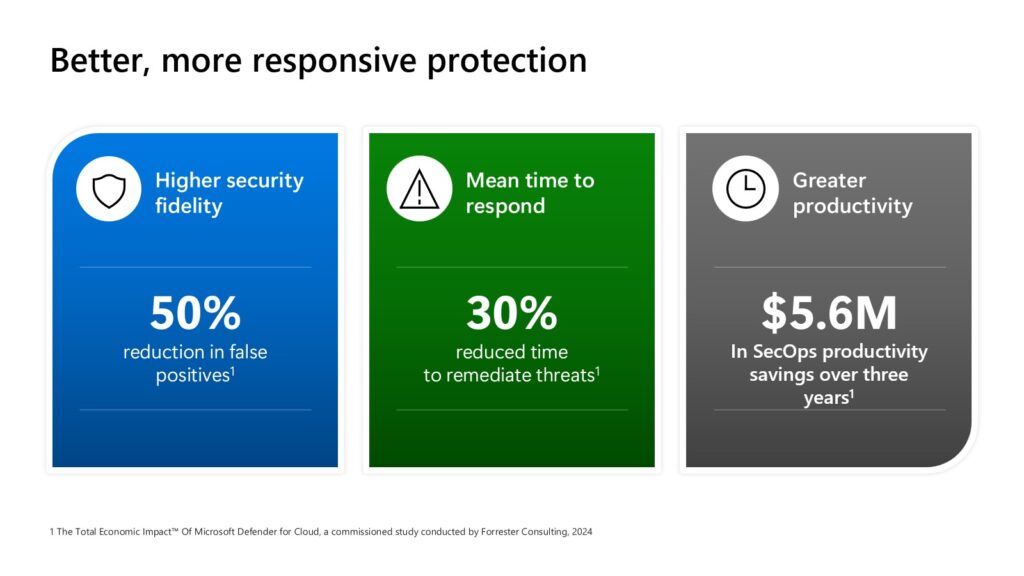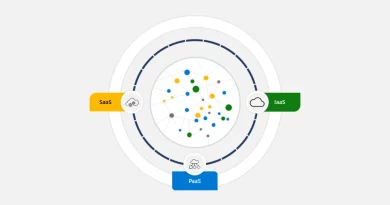Microsoft Defender for Cloud remediated threats 30% faster than other solutions, according to Forrester TEI™ study
The broad adoption of multicloud and hybrid infrastructures has introduced new complexity to the cloud estates of many businesses. With this complexity comes a broader attack surface for would-be data thieves. Sophisticated ransomware attacks that exploit vulnerabilities in cloud infrastructure are on the rise, as are supply chain attacks that target third-party software. Cyberattackers move at lightning speed in the cloud, and, due to the advent of generative AI, their attacks are increasing in number, speed, and sophistication. To address this emergent risk, organizations of all sizes can unify their security and compliance, from code to runtime, in hybrid and multicloud environments with an integrated, generative AI-powered cloud native application protection platform (CNAPP) and better defend themselves against cloud threats.
Microsoft Defender for Cloud, the integrated CNAPP from Microsoft, delivers comprehensive security and compliance from code to runtime, enhanced by generative AI and threat intelligence to help you secure your hybrid and multicloud environments. With Defender for Cloud, organizations can support secure development, minimize risks with contextual posture management, and protect workloads and applications from modern threats in a unified security operations (SecOps) experience.
Defender for Cloud not only transcends traditional security silos and extends its end-to-end security across multicloud and hybrid infrastructure, it delivers advanced security posture management and threat remediation capabilities as well. In order to prove the solution’s business benefits, Microsoft commissioned Forrester Consulting to conduct a Total Economic Impact™ (TEI) study. The study aims to provide business leaders and decision-makers with a solid framework with which they can evaluate the benefits and potential financial impact of Defender for Cloud on their organizations.
Through the course of the study, participating interviewees reported experiencing a wide variety of benefits related to Defender for Cloud, including reduced operational risk, a compressed, more secure development lifecycle, and reduced time to investigate and remediate threats faster.

All told, the study found that the benefits of Defender for Cloud add up to a significant net present value (NPV) of $4.25 million over three years. But that’s not the whole story. Here are some other key takeaways mentioned by Forrester’s interviewees.
“[Defender for Cloud] just takes out the weird stuff happening on our network that ends up on the cybersecurity desk. We’ve already probably cut back about 60% of the workload, and a lot of that revolves around false positives, so I can get better data. The systems assess the data properly…I’m not even going to give it to the analyst. I’m going to auto-close.”
—Chief technology officer, Life Sciences
Defender for Cloud was found to register 50% fewer false positives than legacy security solutions. Simultaneously, the solution reduced the investigation and remediation times of legitimate threats by 30%. Due to these dramatic improvements, study participants avoided 36,000 investigation and remediation hours on average. By reallocating the corresponding $796,000 of SecOps labor to proactive threat hunting and other high-value activities, companies were able to further improve their security performance.
2. Improved security operations center (SOC) productivity
“[With Defender for Cloud], if the tools are configured properly, the [global] efficiencies in your SOC can probably be up to 30% for a fine-tuned environment.”
—Technical manager, Business-to-business Software
By broadening the number and types of workloads protected by Defender for Cloud, participating businesses saw an average 30% improvement in SecOps productivity. This boost was a combination of consolidating duplicative multicloud security policies, replacing patching processes and other similar time-consuming procedures with automation, and embracing the efficiency gains of a better-integrated Microsoft ecosystem. In financial terms, these productivity gains translate to a $5.6 million savings over three years.
3. Lower total cost of ownership
“[Without Defender for Cloud], it would be so much more complex. It would cost us double to maintain [our multicloud security stack].”
—Cyberdefense leader, Materials
Interviewees reported that Defender for Cloud reduced their licensing costs by 10% when compared to legacy security solutions. This savings is the result of eliminating the licensing and management costs associated with five legacy security solutions over three years—made possible because of the breadth of workloads protected by Defender for Cloud. Interviewees also reported 1,700-hour reduction in security stack administrative work thanks to their ability to consolidate workloads across their multicloud infrastructures. These adjustments together yielded more than $1 million in cost savings.
4. More comprehensive cyberthreat coverage and prioritization
“Microsoft is capturing 10% of real incidents [not caught by other solutions deployed], reducing our attack surface by 10%.“
—Chief information security officer (CISO), Technology
Defender for Cloud caught 10% more legitimate cyberthreats than the prior security environments study participants had been using, on average. Each of these threats required a response and would have been missed. Interviewees defined the incidents they had previously lacked the capacity to address a mix of increasingly complex and overlapping cyberthreats that included but were not limited to runtime container risk, overprovisioning container privileges, malware, phishing and social engineering efforts, and shadow IT. Not only did Defender for Cloud identify these incidents, it provided greater context surrounding them, improving threat prioritization and avoiding $292,000 in costs related to data breaches.
5. Lower compliance costs
“[Defender for Cloud] is capable of saving up to 5% of [my organization’s] engineering overhead around [audit and compliance] meetings and collaboration.”
—CISO, Technology
With Defender for Cloud, participating organizations decreased their compliance-related costs. Auditing fees were avoided and compliance-related meeting schedules were streamlined, reducing reliance on outside auditing services. Over three years, the average savings related to these process improvements was $857,000, a 15% reduction in audit compliance overhead.
The advantages of Microsoft Defender for Cloud
Overall, the Forrester study found that Defender for Cloud markedly enhanced the security, compliance, and operational efficiency of each company participating in the TEI study. Through representative interviews and financial analysis, Forrester determined that a composite organization experiencing the aggregate benefits of the study’s participants received $8.52 million in financial benefits over three years. In balancing these benefits against $4.27 million in costs over the same period, Forrester determined that Defender for Cloud represents a net present value (NPV) of $4.25 million.
Interviewees participating in the study went beyond the financial benefits in their praise of Defender for Cloud. After adopting the solution, participants saw reduced risk and improvements to both their security and compliance postures at scale. Even as regulatory and compliance landscapes shifted beneath their feet, these organizations were better able to use the added context of Microsoft cloud security benchmarks to stay on solid ground—remaining compliant when others might not have.
Additionally, interviewees noted that Defender for Cloud helped them more securely collaborate with their technology partners and to establish more secure, more efficient software development pipelines. These benefits, interviewees emphasized, would have further benefits down the road as well, including reduced development times, improved time-to-value, and ultimately greater potential for business growth.
Learn more
To learn more about the business value of Microsoft Defender for Cloud, explore the Total Economic Impact™ Of Microsoft Defender for Cloud study for further analysis and findings, as well as the perspectives of Defender for Cloud users interviewed in the study. Also, register for the webinar featuring Forrester on top cloud security trends, key considerations, and quantifying the business value of CNAPP.
Learn more about Microsoft Cloud Security Solutions.
To learn more about Microsoft Security solutions, visit our website. Bookmark the Security blog to keep up with our expert coverage on security matters. Also, follow us on LinkedIn (Microsoft Security) and X (@MSFTSecurity) for the latest news and updates on cybersecurity.
READ MORE HERE




